



Body Condition Scoring Beef Cows
By Dan E. Eversole, Extension Animal Scientist; Milyssa F. Browne, Graduate Student; John B. Hall, Extension Animal Scientist; and Richard E. Dietz, Graduate Student; Virginia Tech Table of Contents
Table of ContentsOverview
Body Condition Scoring System
Guidelines for Body Condition Scores
Importance of Body Condition
Nutritional Programs Using Body Condition Scores
Summary
References
Overview
Body condition scoring (BCS) is a useful management tool for distinguishing differences in nutritional needs of beef cows in the herd. This system uses a numeric score to estimate body energy reserves in the cow. Research indicates that there is a strong link between the body condition of a cow and her reproductive performance. The percentage of open cows, calving interval, and calf vigor at birth are all closely related to the body condition of cows both at calving and during the breeding season.All these factors play an important role in the economics of a beef cow-calf operation and help determine the percentage of viable calves each year. Monitoring body condition using the BCS system is an important managerial tool for assessing production efficiency.
Body Condition Scoring System
Body Condition Scoring Photo's 1-9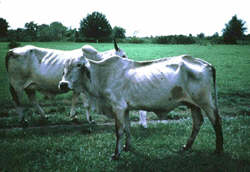 Photo 1: BCS 1. Emaciated with muscle atrophy and no detectable fat. Tail head and ribs project predominantly. Animal physically weak |
 Photo 2: BCS 2. Poor condition with muscle atophy and no detectable fat. Tail head and ribs prominent |
 Photo 3: BCS 3. Thin condition. Slight muscle atrophy. All ribs visible. Very little detectable fat |
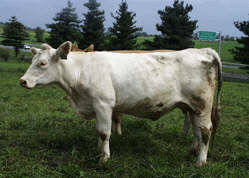 Photo 4: BCS 4. Borderline condition. Outline of spine slightly visible. Outline of 3 to 5 ribs visible. Some fat over ribs and hips |
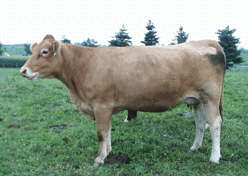 Photo 5: BCS 5. Moderate, good overall apperance. Outline of spine no longer visible. Outline of 1-2 ribs visible. Fat over hips but still visible |
 Photo 6: BCS 6. High moderate condition. Ribs and spine no longer visible. Pressure applied to feel bone structure. Some fat in brisket and flanks |
 Photo 7: BCS 7. Good, fleshy appearance. Hips slightly visible but ribs and spine not visible. Fat in brisket and flanks with slight udder and tail head fat |
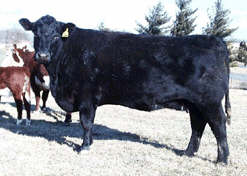 Photo 8: BCS 8. Fat, fleshy and overconditioned. Bone structure not visible. Large patchy fat deposits over ribs, around tail head and brisket |
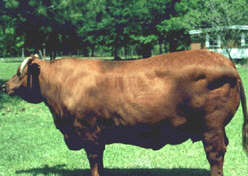 Photo 9: BCS 9. Extremely fat, wasty and patchy. Mobility possibly impaired. Bone structure not visible. Extreme fat deposits over ribs, around tail head and brisket |
Body condition scores are excellent indicators of the nutritional status in beef cows. Ideal liveweight varies from cow to cow whereas ideal body condition (BCS 5-6) is the same for all cows. Also, body condition can be measured in the field without gathering or working cattle. Body condition scores are numbers used to estimate energy reserves in the form of fat and muscle of beef cows. BCS ranges from 1 to 9, with a score of 1 being extremely thin and 9 being very obese. Areas such as the back, tail head, pins, hooks, ribs, and brisket of beef cattle can be used to determine BCS (Figure 1).
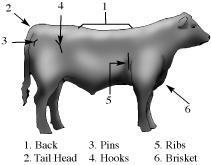 Figure 1. Areas useful for visually determining BCS in beef cows (Oklahoma State University) |
 Figure 2. Specific anatomical areas used in determining BCS in beef cows. (Adapted from Herd and Sprott, 1986) |
A cow in 'thin' condition (BCS 1-4) is angular and bony with minimal fat over the backbone, ribs, hooks, and pins. There is no visible fat around the tail head or brisket. A cow in 'ideal' condition (BCS 5-7) has a good overall appearance. A cow with a BCS of 5 has visible hips, although there is some fat over the hooks and pins and the backbone is no longer visible. Cows with BCS of 6 or 7 become fleshy and the ribs are no longer visible. There is also fat around the tail head and in the brisket.
An over-conditioned cow (BCS 8-9) is smooth and boxy with bone structure hidden from sight or touch. She may have large protruding fat deposits (pones) around the tail head and on the pin bones. Be aware that gut fill due to rumen contents or pregnancy can change the appearance of moderately fleshy cows, especially over the ribs or in front of the hooks. Visual indicators of each BCS are listed in Table 1, and example photos of BCS 1-9 are illustrated in photos 1 through 9.
Long hair can often make it difficult to correctly evaluate the body condition score of a beef cow or heifer. When the hair on the cow is long, palpating the specific areas of fat deposition is particularly important, as shown in Figure 2. Cows should be palpated over the back, ribs, and over the horizontal processes of the backbone (edge of loin). 'Thin' cows will have a sharper feel in these areas than cows with moderate or fat body conditions.
It is important to be aware that the breed of beef cow can have a strong influence on where body fat is deposited. For example, Bos taurus breeds and crossbreds will show a more uniform distribution of fat across the ribs, whereas Bos indicus cattle may have very little fat over the ribs but will deposit fat over the hooks and pin bones.
| Table 1. Reference table for body condition scores | |||||||||
| Body Condition Scores | |||||||||
| Reference Point | 1 | 2 | 3 | 4 | 5 | 6 | 7 | 8 | 9 |
|
Physically weak
|
yes | no | no | no | no | no | no | no | no |
|
Muscle atrophy
|
yes | yes | slight | no | no | no | no | no | no |
|
Outline of spine visible
|
yes | yes | yes | slight | no | no | no | no | no |
|
Outline of ribs visible
|
all | all | all | 3-5 | 1-2 | 0 | 0 | 0 | 0 |
|
Outline of hip bones visible
|
yes | yes | yes | yes | yes | yes | slight | no | no |
|
Fat in brisket and flanks
|
no | no | no | no | no | some | full | full | extreme |
|
Fat udder & patchy fat around tail head
|
no | no | no | no | no | no | slight | yes | extreme |
Guidelines for Body Condition Scores
On average, most beef cows score in the range of 3 to 7 throughout the year. A cow is expected to be in optimal body condition (BCS 5-7) before calving. She may lose condition after calving and possibly into the breeding season. She may gain condition and weight as weaning approaches (assuming there is adequate forage) and continue gaining fetal weight and any needed body condition in late gestation.Body condition should be evaluated and recorded three times a year: at weaning, 60-90 days before calving, and at calving. By assigning BCS scores at the time of weaning, the cows can be sorted for appropriate feeding. Grouping cows by feed requirements and feeding them accordingly can help each of them reach BCS 5-7 by calving. Scoring cows 60-90 days before calving allows you to evaluate your dry cow nutritional program while allowing enough time prior to calving for "emergency feeding" if needed. Although body condition should be evaluated at calving, it may be difficult to increase body condition since lactation requires most of the energy a cow consumes. If environmental conditions at the time of calving are mild, cows may be able to reach BCS 5 or 6 by breeding time. However, this is unlikely to occur when the weather is cold or high quality feeds are limited.
Liveweight should not solely be used as an indicator of nutritional status of beef cows in a herd. Research indicates that body condition is a more reliable indicator of nutritional status than liveweight. Most herds have cows that range in age, frame size, and muscling all of which impact the weight of the animals. Therefore, only using liveweight may over- or under-estimate the amount of body fat. Liveweight is also affected greatly by gut fill and pregnancy. Weight and body condition will vary depending on the physiological state of the cow, forage quality and availability, and the body condition of the cow.
Importance of Body Condition
In order to manage a beef cow-calf operation in the most cost-efficient way, producers must be aware of the body condition of their herd. Research indicates that the body condition of beef cows is related to many critical aspects of production such as conception rate, days to estrus, calving interval, and milk production. When cows are extremely thin (BCS < 4), they are not only reproductively inefficient, but they are more susceptible to health problems. Cows at BCS 1 are in a life-threatening situation and need immediate attention. Cows that are over-conditioned (BCS 8-9) are the most costly to maintain. Two-year-olds with BCS 8-9 may encounter dystocia (calving difficulty) due to the excessive fat in the pelvic area. Table 2 lists many of the production problems associated with cows and heifers in 'thin' or 'fat' condition.| Table 2. Problems associated with "thin" or "fat" body condition | |||||
| Thin Condition BCS 1- 4 | Fat Condition BCS 8-9 | ||||
|
1. Failure to cycle
|
1. Costly to maintain
|
||||
|
2. Failure to conceive
|
2. Increased dystocia
|
||||
|
3. Increased calving interval
|
3. Impaired mobility
|
||||
|
4. Increased days to estrus
|
4. Failure to cycle
|
||||
|
5. Decreased calf vigor
|
5. Failure to conceive
|
||||
Failure to conceive is the most important factor contributing to the reduction of net calf crop. Conception rates are dramatically compromised in cows that are BCS 4 or less. Figure 3 shows the comparison between pregnancy rates and body condition scores and how these two factors impact the break-even cost of a cow-calf operation. In Virginia, the average yearly cost to maintain a cow is $300 per year. The following example also assumes an average weaning weight of 500 pounds and a 90% calf crop weaned. At a BCS of 4, only 50% of the cows were pregnant, resulting in a break-even cost of $133.33/cwt. At a BCS of 5, the 81% pregnancy rate results in a break-even cost of $82.30/cwt, at a BCS of 6 with 88% pregnant, the break-even cost falls to $75.76/cwt and finally, at a BCS of 7, the break-even cost falls to $74.07/cwt. Economically, BCS directly affects net calf crop and the success of a beef cow-calf operation. There is a significant difference in profit margin in percent calf crop between BCS 4 cows and BCS 7 cows.
Figure 3. Comparrison of pregnancy rates and body condition scores on break-even scores in beef cows (Modified from Selk et. al. 1986 Oklahoma State University)
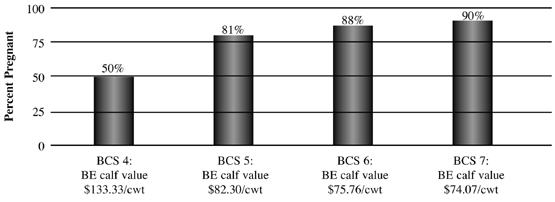
Assumptions for break-even (BE) costs:
Annual cow cost $300
Average weaning weight 500lbs
90% calf crop weaned
90 day breeding season
Research indicates that the body condition of a cow influences days to first estrus after calving and calving interval. A beef cow must conceive within 82 days of the birth of her calf to maintain a 12-month calving interval. Figure 4 illustrates that 91% of the beef cows with BCS >5 at calving showed signs of estrus by 60 days post-calving, whereas only 61% of beef cows with BCS 4, and only 46% of beef cows with BCS <3 showed estrus. The percentage of cows cycling by 80 days postpartum is an important factor affecting calving interval. The rectangular box in Figure 4 shows the critical breeding time in order to achieve a 12-month calving interval. This figure demonstrates the differences in postpartum cyclicity for beef cows at different condition groups. Calving interval is a function of many aspects of reproduction including conception rate and percent cyclicity. If the cows are not cycling, they are not going to conceive, which lengthens the calving interval and negatively impacts profits.
Figure 4. Effect of body condition at calving and subsequent estrus
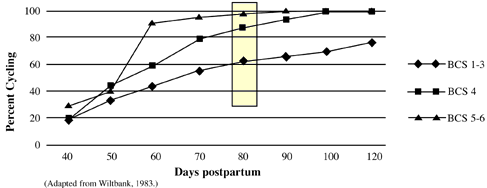
Nutritional Programs Using Body Condition Scores
Since feed costs make up roughly 60% of the cost of a cow-calf operation, different feeding programs can be used to achieve the best reproductive performance without high costs. Choosing a calving season that is most compatible with your forage program is the first step in maximizing cow condition and reproduction. Understand that the changes that occur in body weight and condition are normal in the production cycle of the cow.| Table 3. Recommendations 90 to 100 days prepartum to achieve a BCS of 5 to 7 by calving | |||||
| Score | Desired Condition At Calving | Recommendations | |||
| 1 | 5 | Needs to gain in excess of 350 lb. Economics questionable. | |||
| 2 | 5 | Needs to gain 300 to 350 lb. Economics questionable. | |||
| 3 | 5 | Needs to gain 200 to 300 lb. | |||
| 4 | 5 | Needs to gain 150 to 200 lb. | |||
| 5 | 5-7 | Needs to gain weight of fetus and placenta 100 lb. |
|||
| 6 | 5-7 | Needs to gain weight of fetus and assorted tissues 100 lb. |
|||
| 7 | 5-7 | No weight gain needed. | |||
| 8 | 5-7 | Can probably lose 50 to 100 lb. | |||
| 9 | 5-7 | Can probably lose 100 to 200 lb. | |||
A medium-framed beef cow that is open will gain or lose approximately 75-100 pounds for each body condition score change. For example, a medium-framed beef cow with a BCS 5, weighing 1100 pounds, will be a BCS 3 and weigh approximately 900-950 pounds with a loss of 150-200 pounds and a decrease of two body condition scores.
Moreover, an additional 100 pounds is typically gained during the last trimester of gestation for fetal growth and uterine development. Table 3 shows body condition scores and weight change recommendations for cows achieving a desired BCS of 5-7 90 to 100 days before calving. This is the critical time when the producer has the ability to put condition back on a 'thin' cow or restrict feed intake of a 'fat' cow.
Maintaining and feeding beef cows to attain a BCS in the optimum moderate range (BCS 5-7) allow beef cows to achieve maximum reproductive performance while feed supplementation costs are held to a minimum. In most situations, it is not economically feasible to supplement the entire herd if only half of the cows will respond to the higher level of nutrition. Separating cows based on BCS and feeding them accordingly are good managerial strategies. This should be done at or soon after weaning to allow 2 to 5 months of feeding prior to calving.
Summary
Achieving a BCS of 5 or more before calving and throughout the production cycle is the key to a profitable cow-calf operation. Many producers waste profits by over-feeding cows in adequate condition when only part of the herd needs extra energy and supplementation. By sorting and feeding groups based on BCS, the economics of the operation improve. Producers need to pay attention to stocking rates and pasture quality. Overstocking and poor forage quality can lead to 'thin' cows.As research indicates, monitoring cow condition directly impacts the reproductive performance of the herd. As mentioned above, failure to conceive is the most important factor in reducing net calf crop. Keeping cows in adequate condition throughout the production cycle can improve reproductive performance and positively impact the economics of the operation. The BCS system is relatively easy to learn and can be implemented in any farm situation. Please take the time to learn how to use this system and begin taking advantage of the benefits it has to offer. For help with the BCS system, contact your local Extension agent.
References Beverly, J. R. 1985. Reproduction in beef cattle as related to nutrition and body condition. Kentucky roundup of reproductive efficiency in beef cattle. pp.1-12.
Herd, D. B. and L. R. Sprott. 1986. Body condition, nutrition and reproduction of beef cows. Texas Agricultural Extension Service. Texas A & M Univ. B-1526.
Pruitt, R.J. 1994. Personal Communication. South Dakota State University, Brookings.
Selk, G. E., R. P. Wettemann, K. S. Lusby, and R. J. Rasby. 1986. The importance of body condition at calving on reproduction in beef cows. OSU Agric. Exp. Sta. Publ. 118:3163-3169.
Westendorf, M., C. W. Absher, R. W. Burris, N. Gay, J. T. Johns, and J. D. Miksch. 1988. Scoring beef cow condition. Kentucky Extension Service. ASC-110.
Wiltbank, J. N. 1983. Maintenance of a high level of reproductive performance in the beef cow herd. Vet. Clin. N. Am. Large Anim. Proc. 5:41-57.
December 2000



